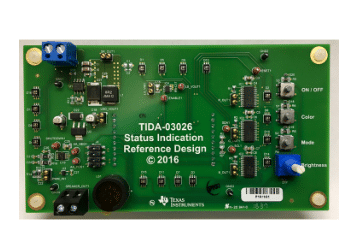Offering customisable visual effects like blinking, pulsing, and breathing alongside audio alerts, this design provides intuitive device status indicators for diverse applications—from IP phones to automotive displays and home automation systems.

The “Status Indication Reference Design with LED and Audio Feedback” provides a practical framework for user interfaces using visual (LED) and auditory signals for precise, intuitive system status communication. This design enables instant, quickly interpretable feedback, essential for applications needing quick status updates, like consumer electronics, industrial equipment, automotive systems, and home automation. Combining LED and audio cues ensures users can perceive system status in quiet and noisy environments, enhancing safety, efficiency, and usability across various settings.
The TIDA-03026 reference design from Texas Instruments offers an advanced solution for status indication in various devices. By enabling synchronised control of multiple LED drivers, this design supports an array of RGB LEDs that display various effects, including blinking, pulsing, and breathing. These visual effects enhance the user experience by providing intuitive feedback on device status. The design also integrates audio input through a miniature speaker, creating a combined status indication system that employs visual and audio cues.
Central to this design is a 16 RGB LED array that responds to user actions via buttons on the PCB. The LEDs can vary in color, brightness, and effects based on button interactions and adjustments to a brightness control knob. The TLC59116 LED driver synchronises multiple LED channels through PWM, enabling unique lighting effects like pulsing and breathing. Its I²C-based control allows easy expansion of LED arrays, making adding additional LEDs simple and customising the user experience across various platforms. It also integrates the TPA6211A1 audio amplifier, a compact and efficient solution for producing audio alerts. This mono, fully-differential amplifier, designed for driving speakers with a minimum impedance of 3 Ω, uses a minimal PCB footprint and operates on low quiescent current, ensuring low power consumption and faster market readiness for new designs.
The TPS22918 load switch reduces LED driver standby current to 0.5 µA, significantly lowering power consumption and making the TIDA-03026 ideal for power-efficient systems. The LMR14030 step-down regulator handles unregulated power sources from 4 to 40 V, suitable for industrial and automotive use. In comparison, the TLV1117 LDO voltage regulator provides a stable voltage of up to 5 V, supporting up to 800 mA. The TPD1E1B04 diode offers robust ESD protection. This design includes tested circuits, guides, and Altium files and streamlining development. Applications include IP phones, HVAC controls, appliances, and automotive displays, offering energy-efficient and versatile status indication across devices.
TI has tested this reference design. It comes with a bill of materials (BOM), schematics, assembly drawing, printed circuit board (PCB) layout, and more. The company’s website has additional data about the reference design. To read more about this reference design, click here.







